k8s通过service访问pod--技术流ken
Posted kenken2018
tags:
篇首语:本文由小常识网(cha138.com)小编为大家整理,主要介绍了k8s通过service访问pod--技术流ken相关的知识,希望对你有一定的参考价值。
service
每个 Pod 都有自己的 IP 地址。当 controller 用新 Pod 替代发生故障的 Pod 时,新 Pod 会分配到新的 IP 地址。这样就产生了一个问题:
如果一组 Pod 对外提供服务(比如 HTTP),它们的 IP 很有可能发生变化,那么客户端如何找到并访问这个服务呢?
Kubernetes 给出的解决方案是 Service。
创建 Service
Kubernetes Service 从逻辑上代表了一组 Pod,具体是哪些 Pod 则是由 label 来挑选。Service 有自己 IP,而且这个 IP 是不变的。客户端只需要访问 Service 的 IP,Kubernetes 则负责建立和维护 Service 与 Pod 的映射关系。无论后端 Pod 如何变化,对客户端不会有任何影响,因为 Service 没有变。
第一步:创建下面的这个 Deployment:
查看支持的apiversion使用命令kubectl api-versions
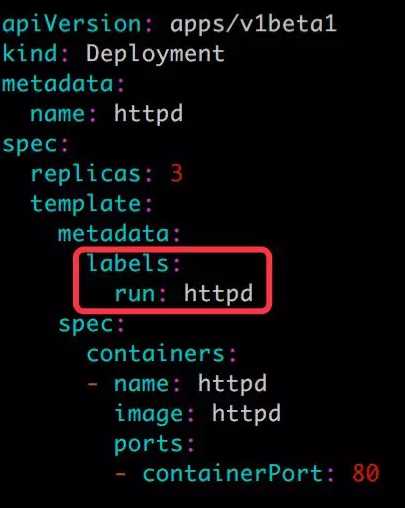
第二步:部署并查看pod
我们启动了三个 Pod,运行 httpd 镜像,label 是 run: httpd,Service 将会用这个 label 来挑选 Pod。
[[email protected] ~]# kubectl apply -f httpd.yml deployment.apps/httpd created [[email protected] ~]# kubectl get pod -o wide NAME READY STATUS RESTARTS AGE IP NODE NOMINATED NODE READINESS GATES httpd-8c6c4bd9b-ljvlb 1/1 Running 0 41s 10.244.1.27 host1 <none> <none> httpd-8c6c4bd9b-ngxqv 1/1 Running 0 41s 10.244.1.28 host1 <none> <none> httpd-8c6c4bd9b-wxblj 1/1 Running 0 41s 10.244.2.18 host2 <none> <none>
第三步:集群内部测试连通性
Pod 分配了各自的 IP,这些 IP 只能被 Kubernetes Cluster 中的容器和节点访问。
[[email protected] ~]# curl 10.244.1.28 <html><body><h1>It works!</h1></body></html> [[email protected] ~]# curl 10.244.1.27 <html><body><h1>It works!</h1></body></html> [[email protected] ~]# curl 10.244.2.18 <html><body><h1>It works!</h1></body></html>
第四步:接下来创建 Service,其配置文件如下:
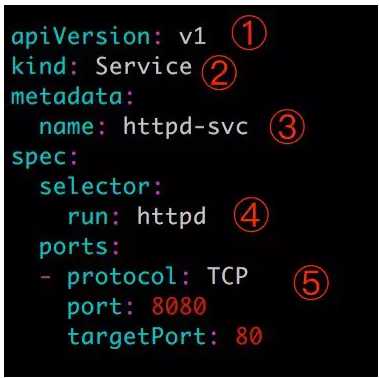
① v1 是 Service 的 apiVersion。
② 指明当前资源的类型为 Service。
③ Service 的名字为 httpd-svc。
④ selector 指明挑选那些 label 为 run: httpd 的 Pod 作为 Service 的后端。
⑤ 将 Service 的 8080 端口映射到 Pod 的 80 端口,使用 TCP 协议。
第五步: 执行 kubectl apply 创建 Service httpd-svc。
[[email protected] ~]# kubectl apply -f service.yml service/httpd-svc created [[email protected] ~]# kubectl get service NAME TYPE CLUSTER-IP EXTERNAL-IP PORT(S) AGE httpd-svc ClusterIP 10.106.64.97 <none> 8080/TCP 17s kubernetes ClusterIP 10.96.0.1 <none> 443/TCP 11h
httpd-svc 分配到一个 CLUSTER-IP 10.106.64.97。可以通过该 IP 访问后端的 httpd Pod。
[[email protected] ~]# curl 10.106.64.97:8080 <html><body><h1>It works!</h1></body></html>
根据前面的端口映射,这里要使用 8080 端口。另外,除了我们创建的 httpd-svc,还有一个 Service kubernetes,Cluster 内部通过这个 Service 访问 kubernetes API Server。
通过 kubectl describe 可以查看 httpd-svc 与 Pod 的对应关系。
[[email protected] ~]# kubectl describe service httpd-svc Name: httpd-svc Namespace: default Labels: <none> Annotations: kubectl.kubernetes.io/last-applied-configuration: {"apiVersion":"v1","kind":"Service","metadata":{"annotations":{},"name":"httpd-svc","namespace":"default"},"spec":{"ports":[{"port":8080,"... Selector: run=httpd Type: ClusterIP IP: 10.106.64.97 Port: <unset> 8080/TCP TargetPort: 80/TCP Endpoints: 10.244.1.27:80,10.244.1.28:80,10.244.2.18:80 Session Affinity: None Events: <none>
Endpoints 罗列了三个 Pod 的 IP 和端口。
DNS访问service
在 Cluster 中,除了可以通过 Cluster IP 访问 Service,Kubernetes 还提供了更为方便的 DNS 访问。
第一步:查看coredns
kubeadm 部署时会默认安装 coredns 组件。
[[email protected] ~]# kubectl get deployment --namespace=kube-system NAME READY UP-TO-DATE AVAILABLE AGE coredns 2/2 2 2 11h
coredns 是一个 DNS 服务器。每当有新的 Service 被创建,coredns 会添加该 Service 的 DNS 记录。Cluster 中的 Pod 可以通过 <SERVICE_NAME>.<NAMESPACE_NAME> 访问 Service。
第二步:dns访问
比如可以用 httpd-svc.default 访问 Service httpd-svc。
[[email protected] ~]# kubectl run busybox --rm -it --image=busybox /bin/sh / # wget httpd-svc:8080 Connecting to httpd-svc:8080 (10.106.64.97:8080) index.html 100% |*************| 45 0:00:00 ETA / # ls bin home root usr dev index.html sys var etc proc tmp / # cat index.html <html><body><h1>It works!</h1></body></html>
由于这个 Pod 与 httpd-svc 同属于 default namespace,可以省略 default 直接用 httpd-svc 访问 Service。
第三步:查看namespace
如果要访问其他 namespace 中的 Service,就必须带上 namesapce 了。kubectl get namespace 查看已有的 namespace。
[[email protected] ~]# kubectl get namespace NAME STATUS AGE default Active 11h kube-public Active 11h kube-system Active 11h
第四步:在 kube-public 中部署 Service httpd2-svc
配置如下:
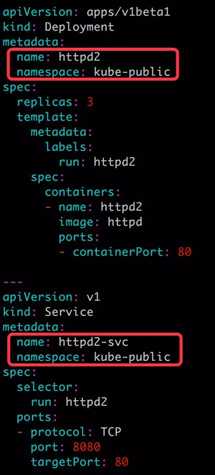
第五步:创建资源
通过 namespace: kube-public 指定资源所属的 namespace。多个资源可以在一个 YAML 文件中定义,用 --- 分割。执行 kubectl apply 创建资源:
[[email protected] ~]# kubectl apply -f service.yml deployment.apps/httpd2 created service/httpd2-svc created
第六步:查看 kube-public 的 Service:
[[email protected] ~]# kubectl get service --namespace=kube-public NAME TYPE CLUSTER-IP EXTERNAL-IP PORT(S) AGE httpd2-svc ClusterIP 10.111.175.138 <none> 8080/TCP 63s
第七步:在 busybox Pod 中访问 httpd2-svc:
[[email protected] ~]# kubectl run busybox --rm -it --image=busybox /bin/sh / # wget httpd2-svc:8080 wget: bad address ‘httpd2-svc:8080‘ / # wget httpd2-svc.kube-public:8080 Connecting to httpd2-svc.kube-public:8080 (10.111.175.138:8080) index.html 100% |*************| 45 0:00:00 ETA
因为属于不同的 namespace,必须使用 httpd2-svc.kube-public 才能访问到。
外网访问service
除了 Cluster 内部可以访问 Service,很多情况我们也希望应用的 Service 能够暴露给 Cluster 外部。Kubernetes 提供了多种类型的 Service,默认是 ClusterIP。
ClusterIP
Service 通过 Cluster 内部的 IP 对外提供服务,只有 Cluster 内的节点和 Pod 可访问,这是默认的 Service 类型,前面实验中的 Service 都是 ClusterIP。
NodePort
Service 通过 Cluster 节点的静态端口对外提供服务。Cluster 外部可以通过 <NodeIP>:<NodePort> 访问 Service。
LoadBalancer
Service 利用 cloud provider 特有的 load balancer 对外提供服务,cloud provider 负责将 load balancer 的流量导向 Service。目前支持的 cloud provider 有 GCP、AWS、Azur 等。
第一步:实践 NodePort,Service httpd-svc 的配置文件修改如下:
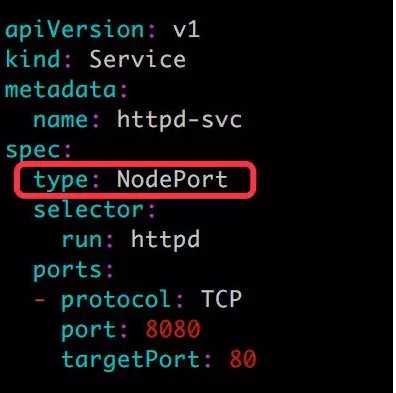
添加 type: NodePort,重新创建 httpd-svc。
第二步:创建service
[[email protected] ~]# kubectl apply -f service.yml service/httpd-svc created [[email protected] ~]# kubectl get service httpd-svc NAME TYPE CLUSTER-IP EXTERNAL-IP PORT(S) AGE httpd-svc NodePort 10.108.118.202 <none> 8080:31785/TCP 12s
Kubernetes 依然会为 httpd-svc 分配一个 ClusterIP,不同的是:
EXTERNAL-IP 为 nodes,表示可通过 Cluster 每个节点自身的 IP 访问 Service。
PORT(S) 为 8080:31785。8080 是 ClusterIP 监听的端口(每个节点都有该端口),31785 则是节点上监听的端口。Kubernetes 会从 30000-32767 中分配一个可用的端口,每个节点都会监听此端口并将请求转发给 Service。
[[email protected] ~]# ss -tnl | grep 31785 LISTEN 0 128 :::31785 :::*
第三步:测试nodeport是否正常工作
[[email protected] ~]# curl 172.20.10.2:31785 <html><body><h1>It works!</h1></body></html> [[email protected] ~]# curl 172.20.10.7:31785 <html><body><h1>It works!</h1></body></html> [[email protected] ~]# curl 172.20.10.9:31785 <html><body><h1>It works!</h1></body></html>
通过三个节点 IP + 32312 端口都能够访问 httpd-svc。
第四步:指定特定端口
NodePort 默认是的随机选择,不过我们可以用 nodePort 指定某个特定端口。
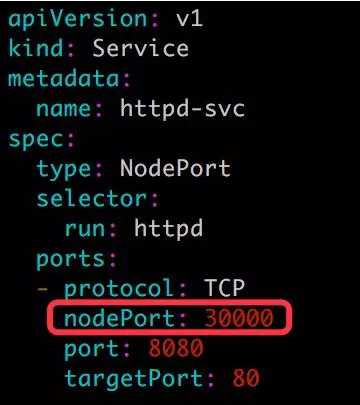
现在配置文件中就有三个 Port 了:
nodePort 是节点上监听的端口。
port 是 ClusterIP 上监听的端口。
targetPort 是 Pod 监听的端口。
最终,Node 和 ClusterIP 在各自端口上接收到的请求都会通过 iptables 转发到 Pod 的 targetPort。
第四步:应用新的 nodePort 并验证:
[[email protected] ~]# kubectl apply -f service.yml service/httpd-svc configured [[email protected] ~]# kubectl get service httpd-svc NAME TYPE CLUSTER-IP EXTERNAL-IP PORT(S) AGE httpd-svc NodePort 10.108.118.202 <none> 8080:30000/TCP 6m8s [[email protected] ~]# curl 172.20.10.2:30000 <html><body><h1>It works!</h1></body></html> [[email protected] ~]# curl 172.20.10.7:30000 <html><body><h1>It works!</h1></body></html> [[email protected] ~]# curl 172.20.10.9:30000 <html><body><h1>It works!</h1></body></html>
nodePort: 30000 已经生效了。